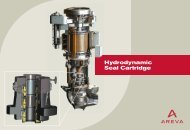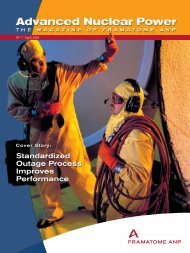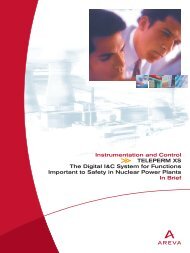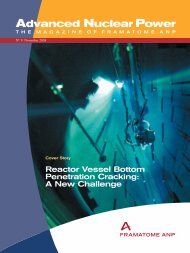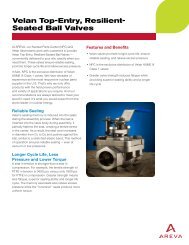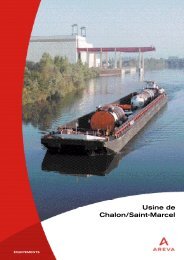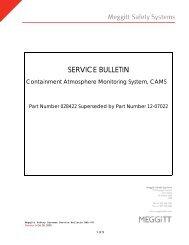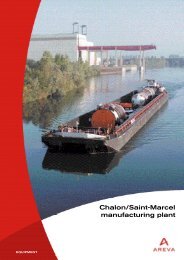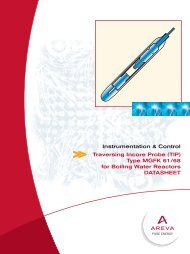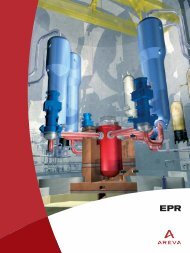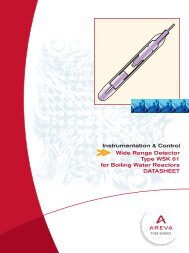Areva EPR
Areva EPR
Areva EPR
Create successful ePaper yourself
Turn your PDF publications into a flip-book with our unique Google optimized e-Paper software.
<strong>EPR</strong> SAFETY<br />
The first important choice, in line with the recommendations of the French and German Safety Authorities,<br />
was to build the <strong>EPR</strong> design upon an evolutionary approach based on the experience feedback from the<br />
96 reactors previously built by Framatome or Siemens. This choice enables the AREVA Group to offer<br />
an evolutionary reactor based on the latest constructions (N4 reactors in France and KONVOI in Germany)<br />
and to avoid the risk arising from the adoption of unproven technologies.<br />
This does not mean that innovative solutions, backed by the results of large-scale research and<br />
development programs, have been left out; indeed, they contribute to the accomplishment of the <strong>EPR</strong><br />
progress objectives, especially in terms of safety and in particular regarding the prevention and mitigation<br />
of hypothetical severe accidents.<br />
These progress objectives, motivated by the continuous search for<br />
a higher safety level, involve reinforced application of the defense in<br />
depth concept:<br />
•by improving the preventive measures in order to further reduce<br />
the probability of core melt,<br />
• by simultaneously incorporating, right from the design stage,<br />
measures for limiting the consequences of a severe accident.<br />
† A two-fold safety approach against<br />
severe accidents:<br />
• further reduce their probability by<br />
reinforced preventive measures,<br />
•drastically limit their potential<br />
consequences.<br />
DESIGN CHOICES FOR REDUCING<br />
THE PROBABILITY OF ACCIDENTS LIABLE<br />
TO CAUSE CORE MELT<br />
In order to further reduce the probability of core melt, which is already<br />
extremely low for the reactors in the current nuclear power plant fleet,<br />
the advances made possible with the <strong>EPR</strong> focus on three areas:<br />
The <strong>EPR</strong> complies with the safety<br />
objectives set up jointly by the French<br />
and German safety authorities for future<br />
PWR power plants:<br />
† further reduction of core melt probability,<br />
† practical elimination of accident<br />
situations which could lead to large<br />
early release of radioactive materials,<br />
† need for only very limited protective<br />
measures in area and time*, in case<br />
of a postulated low pressure core melt<br />
situation.<br />
* No permanent relocation, no need for emergency evacuation outside the<br />
immediate vicinity of the plant, limited sheltering, no long-term restriction in<br />
the consumption of food.<br />
• extension of the range of operating conditions taken into account<br />
right from design,<br />
• the choices regarding equipment and systems, in order to reduce the<br />
risk of seeing an abnormal situation deteriorate into an accident,<br />
• the advance in reliability of operator action.<br />
Extension of the range of operating conditions<br />
taken into account right from design<br />
Provision for the shutdown states in the dimensioning<br />
of the protection and safeguard systems<br />
The probabilistic safety assessments highlighted the importance that<br />
should be given to the reactor shutdown states. For the <strong>EPR</strong>, these<br />
shutdown states were systematically taken into account, both for<br />
the risk analyses and for the dimensioning of the protection and<br />
safeguard systems.<br />
The use of the probabilistic safety assessments<br />
Although the <strong>EPR</strong> safety approach is mainly based on the defense in<br />
depth concept (which is part of a deterministic approach), it is reinforced<br />
by probabilistic analyses. These make it possible to identify the accident<br />
sequences liable to cause core melt or to generate large radioactive<br />
releases, to evaluate their probability and to ascertain their potential<br />
causes so that they can be remedied. In their large scale right from the<br />
design phase, the probabilistic assessments conducted for the <strong>EPR</strong><br />
constitute a world first. They have been a decisive factor in the technical<br />
choices intended to further strengthen the safety level of the <strong>EPR</strong>.<br />
With the <strong>EPR</strong>, the probability of an accident leading to core melt,<br />
already extremely small with the previous-generation reactors,<br />
becomes infinitesimal:<br />
• smaller than 1/100,000 (10 –5 ) per reactor/year, for all types of<br />
failure and hazard, which fully meets the objective set for the new<br />
nuclear power plants by the International Nuclear Safety Advisory<br />
Group (INSAG) with the International Atomic Energy Agency (IAEA)<br />
– INSAG 3 report,<br />
• smaller than 1/1,000,000 (10 –6 ) per reactor/year for the events<br />
generated inside the plant, making a reduction by a factor 10<br />
compared with the most modern reactors currently in operation,<br />
• smaller than 1/10,000,000 (10 –7 ) per reactor/year for the sequences<br />
associated with early loss of the radioactive containment function.<br />
I 47



